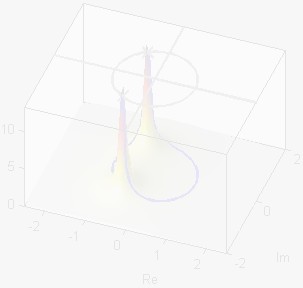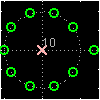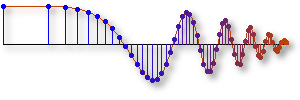Overview:
In this chapter the \(z\)-Transform is introduced for FIR filters. This
algebraic method introduces polynomials into the analysis of linear time-invariant (LTI) systems.
Thus the well-known operations of factoring of polynomials, multiplying and
dividing polynomials have powerful consequences and interpretations for
digital filters. In general, the \(z\)-Transform system functions are
rational functions-the ratio being a numerator polynomial divided by a
denominator polynomial. Of particular interest are the polynomial roots
which, in the case of feedback filters, make up the poles and
zeros of the filter. In the long run, most properties of digital
filters can be restated in terms of the pole and zero locations in the
complex \(z\)-plane. For example, stability of a filter requires that
the poles lie inside the unit circle.
Demos - MATLAB 3
PeZ (pezdemo) is a MATLAB tool for pole/zero manipulation.
Poles and zeros can be placed anywhere on a map of the
\(z\)-plane.
The corresponding time domain (\(n\)) and frequency
domain (\(\hat\omega\)) plots will be displayed.
When a zero pair (or pole pair) is dragged, the
impulse response and frequency response plots will
be updated in real time.
Labs - MATLAB 2
This lab introduces a practical application where sinusoidal signals are used to transmit information: a
touch-tone dialer. Bandpass FIR filters can be used to extract the information encoded in the waveforms.
The goal of this lab is to design and implement bandpass FIR filters in M ATLAB , and to do the decoding
automatically. In the experiments of this lab, you will use
firfilt(), or conv(), to implement filters and
freqz() to obtain the filter’s frequency response. 1 As a result, you should learn how to characterize a filter
by knowing how it reacts to different frequency components in the input.
[Files]
This lab introduces a practical application where we attempt
to extract information from sinusoidal signals -
in this case, piano notes. Bandpass FIR filters can be
used to extract the information encoded in the waveforms.
The goal of this lab is to design and implement several
bandpass FIR filters in MATLAB, and use the
filtered outputs to determine automatically which note is being played.
However, since there are 88 keys on
the piano, we will only require the system to figure
out which octave the note is in, not the exact note. In
the experiments of this lab, you will use
firfilt(), or conv(),
to implement filters and freqz() to
obtain the filter's frequency response. As a result,
you should learn how to characterize a filter by knowing
how it reacts to different frequency components in the input.
[Files]




